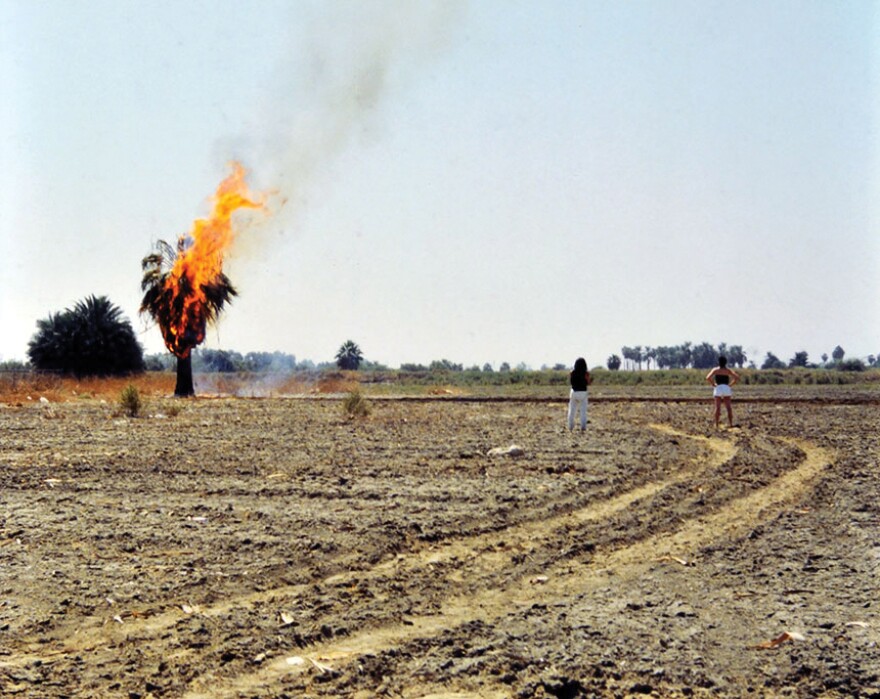Restored and revived, 1991’s Queen of Diamonds is the strangest Vegas film you’ve never seen
There’s a certain glamour to Las Vegas onscreen, even in the grittiest indie productions, that makes the city seem like a magical wonderland, albeit one with an occasional dark side. Nina Menkes’ 1991 film Queen of Diamonds is a harsh antidote to that tendency, depicting Vegas as drab and monotonous and alienating, not dangerous or edgy so much as just exhausting. Menkes’ avant-garde film premiered at the 1991 Sundance Film Festival and received a gorgeous restoration from the Academy Film Archive and the Film Foundation in 2018, which is now streaming on the Criterion Channel alongside a selection of Menkes’ other films.
Menkes’ sister Tinka stars as the unnamed main character, a blackjack dealer at Bob Stupak’s Vegas World who performs her job with a sort of grim competence, and trudges through the rest of her life with the same lack of affect or enthusiasm. The film is full of long, static takes, with the camera often fixed on what appears to be an unremarkable space. The opening shot holds steady on the protagonist’s hand sticking out from under her bed covers, the long, deep red nails contrasting with the plain white sheets. Menkes forces the audience to stare at that image for longer than is comfortable, and the entire movie is composed of those off-putting compositions, challenging the viewer to look away or give up.
There isn’t much of a plot to Queen of Diamonds, which often resembles an art installation more than a narrative film, although there is some progression for the main character as she navigates her meager Vegas existence. She lives in the kind of rundown Downtown motel that has since been obliterated by gentrification, where her neighbors are a bedridden old man and a constantly fighting couple. Menkes shows the character tenderly bathing and feeding the old man, and it takes awhile for the movie to reveal what exactly their relationship is. He’s not a relative or a friend, just a neighbor, and this woman may be helping him out of kindness, or a sense of tired obligation, a fellow Vegas castoff taking care of one of her own.
She’s completely unsentimental about his passing, though, just putting in a bored call to the motel manager: “Yeah, he’s dead.” Menkes treats the domestic violence next door with the same detached resignation. When the protagonist yells at the man for beating his girlfriend, his only response is to clarify that she’s his fiancée, not his girlfriend. Later, the fiancée is showing off her wedding dress while sporting a black eye, and then eating cake and dancing with her new husband at her wedding, all while covered in bruises.
The movie’s centerpiece is a 15-minute sequence of the main character dealing blackjack at Vegas World, with only the background noise of the casino and indiscernible chatter on the soundtrack. After getting the viewer used to her long takes and fixed camera placement, Menkes instead fills this sequence with frequent cuts, often reusing the same shots, emphasizing the repetitive meaninglessness of the character’s occupation. She deals and discards, over and over again, never saying a word or even changing her expression. She takes no pleasure in her job, has no investment in whether the players win or lose. Watching this sequence is almost like sitting in an actual casino and spying on gamblers or attempting to eavesdrop on their conversations, although Menkes never allows the viewer to make out more than a word or two of what anyone is saying.
That makes Queen of Diamonds sound like an endurance test, but while it can be grueling at times, it also has moments of stark beauty. The other standout sequence is an extended wide shot of a burning palm tree somewhere in the desert, and Menkes has the viewer watch along with the protagonist as the tree burns itself out, the crackling and sizzling on the soundtrack like a sort of perverse desert yule log. With the tree looming on one side of the frame and the people reduced to tiny figures, their backs to the camera, on the other side, the image could easily be captured and placed in a gallery. But it’s more powerful as a real-time experience, almost suspenseful as the fire is slowly reduced to embers.
Menkes also provides a fascinating Vegas time capsule, from Vegas World (which was later remodeled as part of the Strat) to vintage wedding chapels to the scuzzy Downtown that no longer exists. But there’s no retro Vegas glamour or nostalgic warmth in their portrayals. The Las Vegas of Queen of Diamonds isn’t a place where dreams come true — or even a place where people bother dreaming at all. It’s a place for the isolated, the disconnected, the people who are used and discarded like the cards that the main character cycles through endlessly. But there’s a certain beauty in that bleakness, and that’s what Menkes (and her protagonist) finds here.
Recent movies like Numa Perrier’s Jezebel and the Ross brothers’ Bloody Nose, Empty Pockets have similarly depicted this downtrodden side of Vegas life, but Queen of Diamonds remains a singular experience, showing a new perspective on the city even to viewers who’ve lived here for decades.










